A multitude of environmental and human factors has created a near “perfect storm” over the past 20 years leading to a population explosion of ticks throughout North America.
There are two families of ticks found in the United States: Ixodidae (hard ticks) and Argasidae (soft ticks). Of the 700 species of hard ticks and 200 species of soft ticks found throughout the world, only a few are known to bite and transmit disease to humans.
Hard ticks and soft ticks have different life cycles, growing larger and changing their appearance at each stage.
Hard ticks (Ixodidae)
Hard ticks (Ixodidae) begin as an egg that is laid by an adult female tick. Once the egg hatches a larva emerges that must then find and feed on a small mammal or bird (host). After feeding it drops to the ground from the host and goes through a molting process, emerging as a nymph.
Nymphal hard ticks then seek larger hosts, and after feeding drop off and molt into adults. The life cycle of hard ticks lasts one to two years depending on the species. The bite of a hard tick is generally painless, with a feeding process lasting several hours, to days, even weeks.
Soft ticks (Argasidae)
Soft ticks (Argasidae), like hard ticks begin as an egg, hatch into a larva, feed and then molt into a nymph. Nymphal soft ticks may go through as many as seven phases as nymphs, requiring a blood meal at each stage.
Soft ticks’ life cycle lasts from months to years depending on the species. The bite is typically painless and only lasts 15-30 minutes, making it harder to detect.
While both hard and soft adult ticks are easiest to identify, it is important to note that nymphal ticks are equally capable of transmitting disease. In some areas the nymphal tick infection rate is actually higher than the adult tick infection rate.
The following is a list of ticks found in the United States that are known to bite and transmit disease to humans:
Know The Types of Ticks
American Dog Tick (Dermacentor variabilis)
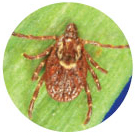
The American dog tick has a dark brown body. Females have an off-white shield, while adult males look more mottled. The greatest risk of being bitten is from the adult females during the spring and summer months.
Pathogens: This species is the primary vector of the bacteria that cause Rocky Mountain spotted fever ((Rickettsia rickettsii)). It is also known to transmit Tularemia (Francisella tularensis), Ehrlichia, Anaplasma, and tick paralysis.
Location: This tick has a broad distribution east of the Rocky Mountains, throughout the East and Gulf Coast, along the Pacific Coast, into Canada and parts of Alaska. American dog ticks are mostly found in areas with little or no tree cover, such as tall grassy fields and low lying brush and twigs, as well as along walkways and trails.
Blacklegged “Deer” Tick (Ixodes scapularis)
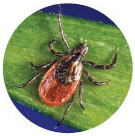
This tick is most easily identified by its reddish-orange body, black shield and dark black legs.
Pathogens: The deer tick is known to transmit Borrelia burgdorferi (the agent of Lyme disease), Borrelia mayonii (which causes a Lyme-like illness), Borrelia miyamotoi and Borrelia hermsii (that both cause relapsing fever Borreliosis), Ehrlichia muris (ehrlichiosis), Anaplasma phagocytophilum (anaplasmosis), Babesia microti (babesiosis), multiple species of Rickettsia, deer tick virus, and Powassan virus. This tick is also suspected of transmitting Bartonella to humans.
Location: Over the last two decades, the distribution of blacklegged ticks has expanded. They are now found throughout the eastern U.S., large areas in the north and central U.S., and the South. The northern distributions of the blacklegged tick are continuing to spread in all directions from two major endemic areas in the Northeast and Upper Midwest. It’s important to note that adult ticks will search for a host any time when temperatures are above freezing, including winter.
Blacklegged ticks are found in a wide variety of habitat that are suitable for birds, large and small mammals such as mice, deer, squirrel, coyotes and livestock. All life stages can bite humans, but nymphs and adult females are most commonly found on people who are in contact with grass, brush, leaves, logs or pets that have been roaming the outdoors.
Brown Dog Tick (Rhipicephalus sanguineus)
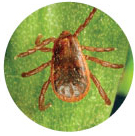
The brown dog tick is a reddish brown with a narrow shape in comparison to other ticks.
Pathogens: All life stages of this tick can transmit Rocky Mountain spotted fever (Rickettsia rickettsia), Q Fever, and other rickettsioses to humans. They can also transmit several diseases specific to dogs.
Location: Dogs are the primary host for the brown dog tick which is found world-wide. The brown dog tick can survive and breed in nature but live primarily in and around homes with dogs (for example, dog beds and kennels). These ticks are capable of spending their entire life cycle indoors.
To eradicate brown dog tick infestations, experts recommend: treating all pets the house and yard, sanitize the pet beds and other areas the dog frequents, including the car. This process may take repeated applications over several months.
Groundhog Tick (Ixodes cookei)
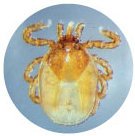
The groundhog tick, also known as woodchuck tick, has a light brown or blond color.
Pathogens: The groundhog tick is the primary vector for Powassan virus disease.
Location: This tick is found throughout the eastern half of the United States. All life stages of this tick feed on a variety of warm-blooded animals, including groundhogs, skunks, squirrels, raccoons, foxes, weasels, and occasionally humans and domestic animals.
Lone Star Tick (Amblyomma americanum)
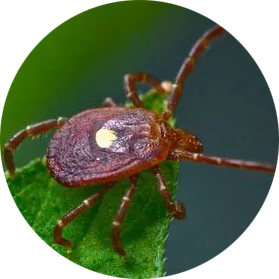
This tick is reddish-brown in color. The adult female is distinguished by a white dot or “lone star” on her back.
Pathogens: The nymphal and adult ticks can transmit human monocytotropic ehrlichiosis (HME), Ehrlichiosis (Ehrlichia chaffeensis, Ehrlichia ewingii, and Panola Mountain ehrlichia), Rickettsiosis, Rocky Mountain spotted fever (RMSF), Tularemia (Francisella tularensis), Heartland virus, Bourbon virus, Q fever and tick paralysis, as well as Borrelia lonestari, which causes Southern tick-associated rash illness “STARI,” an illness almost identical to Lyme.
Location: The lone star tick is widely distributed throughout the Eastern U.S. but is most prevalent in the South. These ticks are notoriously aggressive biters, with the greatest risk of being bitten from early Spring through late Fall.
Note: The bite of this tick has been associated with delayed allergic reactions to the consumption of red meat in some humans. This condition, known as “alpha-gal” allergy, is increasingly being recognized as a health problem throughout this tick’s geographic range.
Pacific Coast Tick (Dermacentor occidentalis)
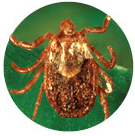
The Pacific Coast tick has a mottled brownish-black color.
Pathogens: All life stages of this tick can transmit Rocky Mountain spotted fever to humans and their pets. It can also transmit Colorado tick fever virus (CTFV), Pacific Coast tick fever (spotted fever Rickettesia 364D), the Rickettsia of Q fever and Rickettsia philippi (a spotted fever rickettsiosis), as well as the bacterium that causes Tularemia. The bite of this tick causes a wound that is commonly mistaken for other biting insects and spiders.
Location: The Pacific coast tick is prevalent in the Southwestern U.S. It has a broad range from Baja Mexico into Oregon. The Pacific Coast ticks are the most common tick found throughout California.
Rocky Mountain Wood Tick (Dermacentor andersoni)
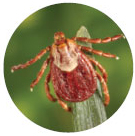
These ticks are reddish-brown and look very similar to American dog ticks. The adult males have a cream-colored shield.
Pathogens: This tick is the primary vector of the Colorado tick fever virus (CTFV), as well as the agents of Rocky Mountain spotted fever (Rickettsia rickettsii), Q fever and tularemia. The saliva of the Rocky Mountain wood tick contains a neurotoxin that can occasionally cause tick paralysis in humans and pets. The toxin takes anywhere from 24-72 hours to dissipate after tick removal.
Location: Rocky Mountain wood ticks are found primarily in scrublands, lightly wooded areas, open grasslands, and along trails. They occupy the area between the eastern and western distribution of the American dog tick and extend into Canada. In the U.S., their geographical distribution is generally restricted to higher elevations above 4,000 feet.
These ticks can be active from January through November, but their activity diminishes during the hot and dry mid-summer period. Adult wood ticks can be found questing about knee-high on the tips of vegetation. They prefer to feed on medium to large mammals, but can survive up to 600 days without feeding.
Soft Ticks (Ornithodoros)
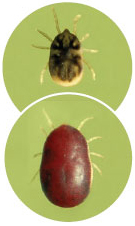
Soft ticks do not have a hard shell and are shaped like a large raisin.
Pathogens: This tick is the primary vector of two principal North American agents of tick-borne relapsing fever (TBRF) known as Borrelia hermsii and Borrelia turicatae.
Location: Soft ticks are distributed widely throughout the western United States, including Texas, and are roughly limited to coniferous forests at elevations between 900 – 2,000 meters above sea level. People usually are bitten as they sleep in rustic mountain cabins that have been previously infested with rodents.
In Texas, TBRF may be associated with the exploration of caves. Because the bite is painless victims are often unaware they have been bitten. Documented outbreaks of TBRF have occurred at national parks and vacation cabins in Colorado, Arizona, and the Lake Tahoe area in California.
Western Blacklegged Tick (Ixodes pacificus)
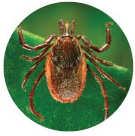
These ticks have a reddish body with a black shield and black legs.
Pathogens: This tick transmits Lyme disease, Borrelia miyamotoi disease (a relapsing fever Borreliosis), babesiosis, ehrlichiosis, and human granulocytic anaplasmosis (HGA). It also is suspected of transmitting Bartonella to humans. Although all life stages of this tick can bite, nymphs and adult females are thought to be the primary cause of illness in humans.
Location: While the western blacklegged tick is most prevalent in California, being established in 55 out of 58 counties, it can also be found in five other western states: Oregon, Washington, Arizona, Nevada and Utah.
Studies indicate the geographic distribution of the western blacklegged tick has not expanded over the past two decades, although active surveillance efforts for this tick outside California have been very limited. The tick can be found along deer trails in grassy coastal regions, dense woodlands, amongst fallen leaves or fir needles, and on fallen logs or branches. Researchers have also found nymphs on the undersides of wooden park benches and tables.
Squirrel, lizards, mice, vole, fox, coyote and deer are common hosts for the western blacklegged tick. Like all ticks, migrating birds act as a long distance transporter. While the majority of cases of Lyme disease are diagnosed in the Northeast and Midwest, it is important to note that some Lyme-endemic counties in California are larger than the states of Rhode Island and Delaware, and the nymphal tick infection rate is comparable to or higher than hyperendemic areas in the northeastern U.S.
- Bishop, F., & Trembley, H. L. (1945). Distribution and hosts of certain North American ticks. J. Parasitol., 31(1), 1-54. DOI: 10.2307/3273061
- Brown, R. N., & Lane, R. S. (1992). Lyme disease in California: a novel enzootic transmission cycle of Borrelia burgdorferi. Science, 256(5062), 1439-1442. DOI: 10.1126/science.1604318
- Burgdorfer, W. (1969). Ecology of tick vectors of American spotted fever. Bull World Health Organ, 40(3), 375-381. [PMID: 5306621]
- Burgdorfer, W., Barbour, A. G., Hayes, S. F., Benach, J. L., Grunwaldt, E., & Davis, J. P. (1982). Lyme disease-a tick-borne spirochetosis? Science, 216(4552), 1317-1319. DOI: 10.1126/science.7043737
- Burgdorfer W, Lane RS, Barbour AG, Gresbrink RA, Anderson JR. (1985) The western black-legged tick, Ixodes pacificus: a vector of Borrelia burgdorferi. Am J of Trop Med. DOI: https://doi.org/10.4269/ajtmh.1985.34.925
- Centers for Disease Control and Prevention | On-line: Tickborne Diseases of the United States.
- Childs, J. E., & Paddock, C. D. (2003). The ascendancy of Amblyomma americanum as a vector of pathogens affecting humans in the United States. Annu Rev Entomol, 48, 307-337. doi:10.1146/annurev.ento.48.091801.112728
- de la Fuente, J., Antunes, S., Bonnet, S., Cabezas-Cruz, A., Domingos, A. G., Estrada-Pena, A., . . . Rego, R. O. M. (2017). Tick-Pathogen Interactions and Vector Competence: Identification of Molecular Drivers for Tick-Borne Diseases. Front Cell Infect Microbiol, 7, 114. doi:10.3389/fcimb.2017.00114
- Diuk-Wasser, M. A., Hoen, A. G., Cislo, P., Brinkerhoff, R., Hamer, S. A., Rowland, M., . . . Fish, D. (2012). Human risk of infection with Borrelia burgdorferi, the Lyme disease agent, in eastern United States. Am J Trop Med Hyg, 86(2), 320-327. doi:10.4269/ajtmh.2012.11-0395
- Drexler, N., Miller, M., Gerding, J., Todd, S., Adams, L., Dahlgren, F. S., . . . McQuiston, J. H. (2014). Community-based control of the brown dog tick in a region with high rates of Rocky Mountain spotted fever, 2012-2013. PLoS One, 9(12), e112368. doi:10.1371/journal.pone.0112368
- Durden, L. A., & Mans, B. J. (2016). Tick paralysis: some host and tick perspectives. In J. J. Janovy & G. W. Esch (Eds.), A Century of Parasitology: Discoveries, Ideas and Lessons Learned by Scientists Who Published in the Journal of Parasitology, 1914-2014 (pp. 167-176): Wiley.
- Dworkin, M. S., Anderson, D. E., Jr., Schwan, T. G., Shoemaker, P. C., Banerjee, S. N., Kassen, B. O., & Burgdorfer, W. (1998). Tick-borne relapsing fever in the northwestern United States and southwestern Canada. Clin Infect Dis, 26(1), 122-131. DOI: 10.1086/516273
- Dworkin, M. S., Schwan, T. G., Anderson, D. E., Jr., & Borchardt, S. M. (2008). Tick-borne relapsing fever. Infect Dis Clin North Am, 22(3), 449-468, viii. doi: 10.1016/j.idc.2008.03.006
- Eisen, L., Dolan, M. C., Piesman, J., & Lane, R. S. (2003). Vector competence of Ixodes pacificus and I. spinipalpis (Acari: Ixodidae), and reservoir competence of the dusky-footed woodrat (Neotoma fuscipes) and the deer mouse (Peromyscus maniculatus), for Borrelia bissettii. J Med Entomol, 40(3), 311-320. DOI: 10.1603/0022-2585-40.3.311
- Eisen, R. J., & Eisen, L. (2018). The Blacklegged Tick, Ixodes scapularis: An Increasing Public Health Concern. Trends Parasitol, 34(4), 295-309. doi:10.1016/j.pt.2017.12.006
- Eisen, R. J., Eisen, L., & Beard, C. B. (2016). County-Scale Distribution of Ixodes scapularis and Ixodes pacificus (Acari: Ixodidae) in the Continental United States. J Med Entomol, 53(2), 349-386. doi:10.1093/jme/tjv237
- Eisen, R. J., Eisen, L., Girard, Y. A., Fedorova, N., Mun, J., Slikas, B., . . . Lane, R. S. (2010). A spatially-explicit model of acarological risk of exposure to Borrelia burgdorferi-infected Ixodes pacificus nymphs in northwestern California based on woodland type, temperature, and water vapor. Ticks Tick Borne Dis, 1(1), 35-43. doi:10.1016/j.ttbdis.2009.12.002
- Eisen, R. J., Kugeler, K. J., Eisen, L., Beard, C. B., & Paddock, C. D. (2017). Tick-Borne Zoonoses in the United States: Persistent and Emerging Threats to Human Health. ILAR J, 1-17. doi:10.1093/ilar/ilx005
- Emmons, R. W. (1988). Ecology of Colorado tick fever. Annu Rev Microbiol, 42, 49-64. doi:10.1146/annurev.mi.42.100188.000405
- Estrada-Pena, A., & de la Fuente, J. (2014). The ecology of ticks and epidemiology of tick-borne viral diseases. Antiviral Res, 108, 104-128. doi:10.1016/j.antiviral.2014.05.016
- Felz, M. W., Durden, L. A., & Oliver, J. H., Jr. (1996). Ticks parasitizing humans in Georgia and South Carolina. J Parasitol, 82(3), 505-508. DOI: 10.2307/3284095
- Goddard, J. (2002). A ten-year study of tick biting in Mississippi: implications for human disease transmission. J Agromedicine, 8(2), 25-32. doi:10.1300/J096v08n02_06
- Godsey, M. S., Jr., Savage, H. M., Burkhalter, K. L., Bosco-Lauth, A. M., & Delorey, M. J. (2016). Transmission of Heartland Virus (Bunyaviridae: Phlebovirus) by Experimentally Infected Amblyomma americanum (Acari: Ixodidae). J Med Entomol. doi:10.1093/jme/tjw080
- Hahn, M. B., Jarnevich, C. S., Monaghan, A. J., & Eisen, R. J. (2016). Modeling the Geographic Distribution of Ixodes scapularis and Ixodes pacificus (Acari: Ixodidae) in the Contiguous United States. J Med Entomol. doi:10.1093/jme/tjw076
- James, A. M., Burdett, C., McCool, M. J., Fox, A., & Riggs, P. (2015). The geographic distribution and ecological preferences of the American dog tick, Dermacentor variabilis (Say), in the U.S.A. Med Vet Entomol, 29(2), 178-188. doi:10.1111/mve.12099
- James, A. M., Freier, J. E., Keirans, J. E., Durden, L. A., Mertins, J. W., & Schlater, J. L. (2006). Distribution, seasonality, and hosts of the Rocky Mountain wood tick in the United States. J Med Entomol, 43(1), 17-24. doi: https://doi.org/10.1093/jmedent/43.1.17
- Jasinskas, A., Zhong, J., & Barbour, A. G. (2007). Highly prevalent Coxiella sp. bacterium in the tick vector Amblyomma americanum. Appl Environ Microbiol, 73(1), 334-336. doi:10.1128/AEM.02009-06
- Kingry, L. C., Anacker, M., Pritt, B., Bjork, J., Respicio-Kingry, L., Liu, G., . . . Petersen, J. M. (2017). Surveillance for and Discovery of Borrelia Species in US Patients Suspected of Tickborne Illness. Clin Infect Dis. doi:10.1093/cid/cix1107
- Lane, R. S., Fedorova, N., Kleinjan, J. E., & Maxwell, M. (2013). Eco-epidemiological factors contributing to the low risk of human exposure to ixodid tick-borne borreliae in southern California, USA. Ticks Tick Borne Dis, 4(5), 377-385. doi:10.1016/j.ttbdis.2013.02.005
- Lane, R. S., Mun, J., Peribanez, M. A., & Stubbs, H. A. (2007). Host-seeking behavior of Ixodes pacificus (Acari: Ixodidae) nymphs in relation to environmental parameters in dense-woodland and woodland-grass habitats. J Vector Ecol, 32(2), 342-357. doi: https://doi.org/10.3376/1081-1710(2007)32%5B342:HBOIPA%5D2.0.CO;2
- Lane, R. S., & Quistad, G. B. (1998). Borreliacidal factor in the blood of the western fence lizard (Sceloporus occidentalis). J Parasitol, 84(1), 29-34. [PMID: 9488334]
- Lane, R. S., Steinlein, D. B., & Mun, J. (2004). Human behaviors elevating exposure to Ixodes pacificus (Acari: Ixodidae) nymphs and their associated bacterial zoonotic agents in a hardwood forest. J Med Entomol, 41(2), 239-248. doi:10.1603/0022-2585-41.2.239
- Levin, M. L., Zemtsova, G. E., Killmaster, L. F., Snellgrove, A., & Schumacher, L. B. M. (2017). Vector competence of Amblyomma americanum (Acari: Ixodidae) for Rickettsia rickettsii. Ticks Tick Borne Dis, 8(4), 615-622. doi:10.1016/j.ttbdis.2017.04.006
- Lopez, J. E., Krishnavahjala, A., Garcia, M. N., & Bermudez, S. (2016). Tick-Borne Relapsing Fever Spirochetes in the Americas. Vet Sci, 3(3). doi:10.3390/vetsci3030016
- Loss, S. R., Noden, B. H., Hamer, G. L., & Hamer, S. A. (2016). A quantitative synthesis of the role of birds in carrying ticks and tick-borne pathogens in North America. Oecologia, 182(4), 947-959. doi:10.1007/s00442-016-3731-1
- Margos, G., Fedorova, N., Kleinjan, J. E., Hartberger, C., Schwan, T. G., Sing, A., & Fingerle, V. (2017). Borrelia lanei sp. nov. extends the diversity of Borrelia species in California. Int J Syst Evol Microbiol, 67(10), 3872-3876. doi:10.1099/ijsem.0.002214
- Minigan, J. N., Hager, H. A., Peregrine, A. S., & Newman, J. A. (2018). Current and potential future distribution of the American dog tick (Dermacentor variabilis, Say) in North America. Ticks Tick Borne Dis, 9(2), 354-362. doi:10.1016/j.ttbdis.2017.11.012
- Monzon, J. D., Atkinson, E. G., Henn, B. M., & Benach, J. L. (2016). Population and Evolutionary Genomics of Amblyomma americanum, an Expanding Arthropod Disease Vector. Genome Biol Evol, 8(5), 1351-1360. doi:10.1093/gbe/evw080
- Neelakanta, G., Sultana, H., Fish, D., Anderson, J. F., & Fikrig, E. (2010). Anaplasma phagocytophilum induces Ixodes scapularis ticks to express an antifreeze glycoprotein gene that enhances their survival in the cold. J Clin Invest, 120(9), 3179-3190. doi:10.1172/JCI42868
- Newman, E. A., Eisen, L., Eisen, R. J., Fedorova, N., Hasty, J. M., Vaughn, C., & Lane, R. S. (2015). Borrelia burgdorferi sensu lato spirochetes in wild birds in northwestern California: associations with ecological factors, bird behavior and tick infestation. PLoS One, 10(2), e0118146. doi:10.1371/journal.pone.0118146
- Ostfeld, R. S., & Keesing, F. (2000). Biodiversity and Disease Risk: the Case of Lyme Disease. Conservation Biology, 14(3), 722-728. doi: https://doi.org/10.1046/j.1523-1739.2000.99014.x
- Padgett KA, Bonilla DL. (2011) Novel exposure sites for nymphal Ixodes pacificus within picnic areas. Ticks and Tick-borne Diseases. 2(4), 191-195. doi: https://doi.org/10.1016/j.ttbdis.2011.07.002
- Paddock, C. D., & Goddard, J. (2015). The Evolving Medical and Veterinary Importance of the Gulf Coast tick (Acari: Ixodidae). J Med Entomol, 52(2), 230-252. doi:10.1093/jme/tju022
- Rudenko, N., Golovchenko, M., Clark, K., Oliver, J. H., & Grubhoffer, L. (2016). Detection of Borrelia burgdorferi sensu stricto in Amblyomma americanum ticks in the southeastern United States: the case of selective compatibility. Emerg Microbes Infect, 5, e48. doi:10.1038/emi.2016.45
- Rudenko, N., Golovchenko, M., Lin, T., Gao, L., Grubhoffer, L., & Oliver, J. H., Jr. (2009). Delineation of a new species of the Borrelia burgdorferi Sensu Lato Complex, Borrelia americana sp. nov. J Clin Microbiol, 47(12), 3875-3880. doi:10.1128/JCM.01050-09
- Salkeld, D. J., & Lane, R. S. (2010). Community ecology and disease risk: lizards, squirrels, and the Lyme disease spirochete in California, USA. Ecology, 91(1), 293-298. doi: https://doi.org/10.1890/08-2106.1
- Salkeld, D. J., Leonhard, S., Girard, Y. A., Hahn, N., Mun, J., Padgett, K. A., & Lane, R. S. (2008). Identifying the reservoir hosts of the Lyme disease spirochete Borrelia burgdorferi in California: the role of the western gray squirrel (Sciurus griseus). Am J Trop Med Hyg, 79(4), 535-540. [PMID: PMC2592199]
- Savage, H. M., Burkhalter, K. L., Godsey, M. S., Jr., Panella, N. A., Ashley, D. C., Nicholson, W. L., & Lambert, A. J. (2017). Bourbon Virus in Field-Collected Ticks, Missouri, USA. Emerg Infect Dis, 23(12), 2017-2022. doi:10.3201/eid2312.170532
- Savage, H. M., Godsey, M. S., Jr., Panella, N. A., Burkhalter, K. L., Ashley, D. C., Lash, R. R., . . . Nicholson, W. L. (2016). Surveillance for Heartland Virus (Bunyaviridae: Phlebovirus) in Missouri During 2013: First Detection of Virus in Adults of Amblyomma americanum (Acari: Ixodidae). J Med Entomol, 53(3), 607-612. doi:10.1093/jme/tjw028
- Savage, H. M., Godsey, M. S., Jr., Panella, N. A., Burkhalter, K. L., Manford, J., Trevino-Garrison, I. C., . . . Raghavan, R. K. (2018). Surveillance for Tick-Borne Viruses Near the Location of a Fatal Human Case of Bourbon Virus (Family Orthomyxoviridae: Genus Thogotovirus) in Eastern Kansas, 2015. J Med Entomol. doi:10.1093/jme/tjx251
- Schwan, T. G., Raffel, S. J., Schrumpf, M. E., Schrumpf, M. E., Webster, L. S., Marques, A. R., . . . Hu, R. (2009). Tick-borne relapsing fever and Borrelia hermsii, Los Angeles County, California, USA. Emerg Infect Dis, 15(7), 1026-1031. doi:10.3201/eid1507.090223
- Sonenshine, D. E. (2018). Range Expansion of Tick Disease Vectors in North America: Implications for Spread of Tick-Borne Disease. Int J Environ Res Public Health, 15(3). doi:10.3390/ijerph15030478
- Spielman, A., Levine, J. F., & Wilson, M. L. (1984). Vectorial capacity of North American Ixodes ticks. Yale J Biol Med, 57(4), 507-513. PMID: 6516453
- Springer, Y. P., Eisen, L., Beati, L., James, A. M., & Eisen, R. J. (2014). Spatial distribution of counties in the continental United States with records of occurrence of Amblyomma americanum (Ixodida: Ixodidae). J Med Entomol, 51(2), 342-351. doi: https://doi.org/10.1603/me13115
- Stafford, K. C. (2004). Tick management handbook. An integrated guide for homeowners, pest control operators and public health officials for the prevention of tick-associated diseases. New Haven, USA: The Connecticut Agricultural Experiment Station. Retrieved from http://www.ct.gov/caes/lib/caes/documents/special_features/tickhandbook.pdf - PDF
- Steinke, J. W., Platts-Mills, T. A., & Commins, S. P. (2015). The alpha-gal story: lessons learned from connecting the dots. J Allergy Clin Immunol, 135(3), 589-596; quiz 597. doi:10.1016/j.jaci.2014.12.1947
- Talleklint-Eisen L, Lane RS. (1999) Variation in the Density of Questing Ixodes pacificus (Acari: Ixodidae) Nymphs Infected with Borrelia burgdorferi at Different Spatial Scales in California. J Parasitol. Oct;85(5):824-31 PMID: 10577716
- Teel, P. D., Ketchum, H. R., Mock, D. E., Wright, R. E., & Strey, O. F. (2010). The Gulf Coast tick: a review of the life history, ecology, distribution, and emergence as an arthropod of medical and veterinary importance. J Med Entomol, 47(5), 707-722. doi: https://doi.org/10.1603/ME10029
- TickEncounter Resource Center. (2019). Retrieved from http://tickencounter.org/prevention
- Tokarz, R., Sameroff, S., Tagliafierro, T., Jain, K., Williams, S. H., Cucura, D. M., . . . Lipkin, W. I. (2018). Identification of Novel Viruses in Amblyomma americanum, Dermacentor variabilis, and Ixodes scapularis Ticks. mSphere, 3(2). doi:10.1128/mSphere.00614-17
- Zeidner, N. S., Burkot, T. R., Massung, R., Nicholson, W. L., Dolan, M. C., Rutherford, J. S., . . . Maupin, G. O. (2000). Transmission of the agent of human granulocytic ehrlichiosis by Ixodes spinipalpis ticks: evidence of an enzootic cycle of dual infection with Borrelia burgdorferi in Northern Colorado. J Infect Dis, 182(2), 616-619. doi:10.1086/315715




















